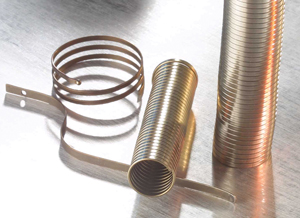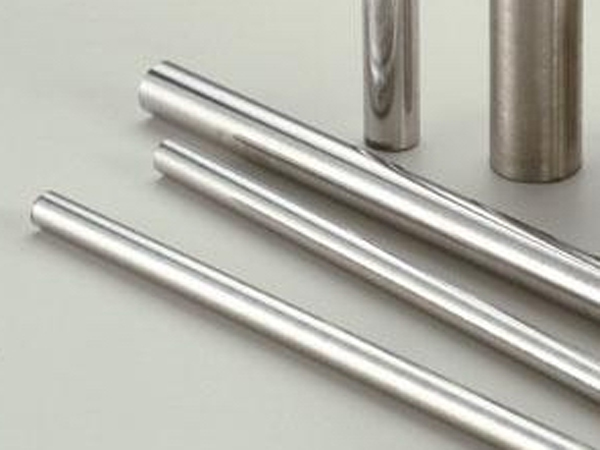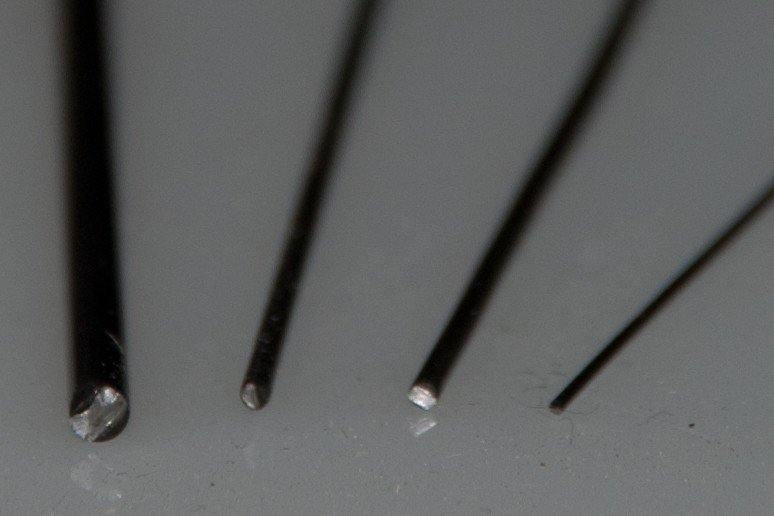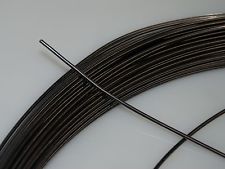
NEW TECHNOLOGIES
NEW TECHNOLOGIES
NEW TECHNOLOGY




INTRODUCTION TO SHAPE MEMORY ALLOYS
Shape Memory Alloys (SMA's) are novel materials which have the ability to return to a predetermined shape when heated. When an
SMA is cold, or below its transformation temperature, it has a very low yield strength and can be deformed quite easily into any
new shape--which it will retain. However, when the material is heated above its transformation temperature it undergoes a change
in crystal structure which causes it to return to its original shape. If the SMA encounters any resistance during this
transformation, it can generate extremely large forces. This phenomenon provides a unique mechanism for remote actuation.
The most common shape memory material is an alloy of nickel and titanium called Nitinol. This particular all
oy has very good electrical and mechanical properties, long fatigue life, and high corrosion resistance. As an actuator, it is capable of up to 5% strain
recovery and 50,000 psi restoration stress with many cycles. By example, a Nitinol wire 0.020 inches in diameter can lift as much as 16 pounds. Nitinol also has the resistance
properties which enable it to be actuated electrically by joule heating. When an electric current is passed directly through the wire, it can generate enough heat to cause the phase transformation. In most cases, the transition temperature of the SMA is chosen such that room temperature is well below the transformation point of the material. Only with the intentional addition of heat can the SMA exhibit actuation. In essence, Nitinol is an actuator, sensor, and heater all in one material. Shape memory alloys, however, are not for all applications. One must take into account the forces, displacements, temperature conditions, and cycle rates required of a particular actuator. The advantages of Nitinol become more pronounced as the size of the application decreases. Large mechanisms may find solenoids, motors, and electromagnets more appropriate. But in applications where such actuators can not be used, shape memory alloys provide an excellent alternative. There are few actuating mechanisms which produce more useful work per unit volume than Nitinol. Nitinol is available in the form of wire, rod and bar stock, and thin film. Examples of SMA products developed by TiNi Alloy Company include silicon micro-machined gas flow microvalves, non-explosive release devices, tactile feedback device (skin stimulators), and aerospace latching mechanisms. If you are considering an application for shape memory alloys, TiNi Alloy Company can assist you in the design, prototyping, and manufacture of actuators and devices.
Shape Memory Alloys (SMA's) are novel materials which have the ability to return to a predetermined shape when heated. When an
SMA is cold, or below its transformation temperature, it has a very low yield strength and can be deformed quite easily into any
new shape--which it will retain. However, when the material is heated above its transformation temperature it undergoes a change
in crystal structure which causes it to return to its original shape. If the SMA encounters any resistance during this
transformation, it can generate extremely large forces. This phenomenon provides a unique mechanism for remote actuation.
The most common shape memory material is an alloy of nickel and titanium called Nitinol. This particular all
oy has very good electrical and mechanical properties, long fatigue life, and high corrosion resistance. As an actuator, it is capable of up to 5% strain
recovery and 50,000 psi restoration stress with many cycles. By example, a Nitinol wire 0.020 inches in diameter can lift as much as 16 pounds. Nitinol also has the resistance
properties which enable it to be actuated electrically by joule heating. When an electric current is passed directly through the wire, it can generate enough heat to cause the phase transformation. In most cases, the transition temperature of the SMA is chosen such that room temperature is well below the transformation point of the material. Only with the intentional addition of heat can the SMA exhibit actuation. In essence, Nitinol is an actuator, sensor, and heater all in one material. Shape memory alloys, however, are not for all applications. One must take into account the forces, displacements, temperature conditions, and cycle rates required of a particular actuator. The advantages of Nitinol become more pronounced as the size of the application decreases. Large mechanisms may find solenoids, motors, and electromagnets more appropriate. But in applications where such actuators can not be used, shape memory alloys provide an excellent alternative. There are few actuating mechanisms which produce more useful work per unit volume than Nitinol. Nitinol is available in the form of wire, rod and bar stock, and thin film. Examples of SMA products developed by TiNi Alloy Company include silicon micro-machined gas flow microvalves, non-explosive release devices, tactile feedback device (skin stimulators), and aerospace latching mechanisms. If you are considering an application for shape memory alloys, TiNi Alloy Company can assist you in the design, prototyping, and manufacture of actuators and devices.
YOU TUBE VIDEOS ON NITINOL HEAT ENGINES
YOU TUBE VIDEOS ON NITINOL EXPERIMENTS AND USES
The term nitinol is derived from its composition and its place of discovery: (Nickel Titanium-Naval Ordnance Laboratory). William J. Buehler[1] along with Frederick Wang,[2] discovered its properties during research at the Naval Ordnance Laboratory in 1959.[3][4] William Buehler was attempting to make a better missile nose cone, which could resist fatigue, heat and the force of impact. Having found that a 1:1 alloy of nickel and titanium could do the job, in 1961 he presented a sample at a laboratory management meeting. The sample, folded up like an accordion, was passed around and flexed by the participants. One of them applied heat from his pipe lighter to the sample and, to everyone's surprise, the accordion-shaped strip stretched and took its previous shape.[5]
While the potential applications for nitinol were realized immediately, practical efforts to commercialize the alloy did not take place until a decade later. This delay was largely because of the extraordinary difficulty of melting, processing and machining the alloy. Even these efforts encountered financial challenges that were not readily overcome until the 1990s, when these practical difficulties finally began to be resolved.
The discovery of the shape-memory effect in general dates back to 1932, when Swedish chemist Arne Ölander[6] first observed the property in gold-cadmium alloys. The same effect was observed in Cu-Zn (brass) in the early 1950s.[7]
While the potential applications for nitinol were realized immediately, practical efforts to commercialize the alloy did not take place until a decade later. This delay was largely because of the extraordinary difficulty of melting, processing and machining the alloy. Even these efforts encountered financial challenges that were not readily overcome until the 1990s, when these practical difficulties finally began to be resolved.
The discovery of the shape-memory effect in general dates back to 1932, when Swedish chemist Arne Ölander[6] first observed the property in gold-cadmium alloys. The same effect was observed in Cu-Zn (brass) in the early 1950s.[7]

THE THERMOBILE (A NITINOL HEAT ENGINE CONCEPT)
HISTORY
Physical Properties of Nitinol
• Density: 6.45gms/cc
• Melting Temperature: 1240-1310° C
• Resistivity (hi-temp state): 82 uohm-cm
• Resistivity (lo-temp state): 76 uohm-cm
• Thermal Conductivity: 0.1 W/cm-° C
• Heat Capacity: 0.077 cal/gm-° C
• Latent Heat: 5.78 cal/gm; 24.2 J/gm
• Magnetic Susceptibility (hi-temp): 3.8 uemu/gm
• Magnetic Susceptibility (lo-temp): 2.5 uemu/gm
Mechanical Properties of Nitinol
• Ultimate Tensile Strength: 754 - 960 MPaor110 - 140 ksi
• Typical Elongation to Fracture: 15.5 percent
• Typical Yield Strength (hi-temp): 560 MPa, 80ksi
• Typical Yield Strength (lo-temp): 100 MPa, 15 ksi
• Approximate Elastic Modulus (hi-tem): 75 GPa, 11 Mpsi
• Approximate Elastic Modulus (l
o-temp): 28 GPa, 4 Mpsi
• Approximate Poisson's Ratio: 0.3
• Density: 6.45gms/cc
• Melting Temperature: 1240-1310° C
• Resistivity (hi-temp state): 82 uohm-cm
• Resistivity (lo-temp state): 76 uohm-cm
• Thermal Conductivity: 0.1 W/cm-° C
• Heat Capacity: 0.077 cal/gm-° C
• Latent Heat: 5.78 cal/gm; 24.2 J/gm
• Magnetic Susceptibility (hi-temp): 3.8 uemu/gm
• Magnetic Susceptibility (lo-temp): 2.5 uemu/gm
Mechanical Properties of Nitinol
• Ultimate Tensile Strength: 754 - 960 MPaor110 - 140 ksi
• Typical Elongation to Fracture: 15.5 percent
• Typical Yield Strength (hi-temp): 560 MPa, 80ksi
• Typical Yield Strength (lo-temp): 100 MPa, 15 ksi
• Approximate Elastic Modulus (hi-tem): 75 GPa, 11 Mpsi
• Approximate Elastic Modulus (l
o-temp): 28 GPa, 4 Mpsi
• Approximate Poisson's Ratio: 0.3
LINKS TO PURCHASE NITINOL PRODUCTS
NITINOL WIRE
NITINOL MUSCLE WIRE ON EBAY
NITINOL HEAT ENGINE ON AMAZON




BLOOMBERG TECHNOLOGY NEWS
Tech Live 2023: What’s Next for OpenAI?
Pentagon Confirms Antigravity UFO That NO One Can Detect
This is a non-profit web site, dedicated to educational study and research. All copyrights belong to their owners and are acknowledged. All material presented on this web site is either news reporting or information presented for non-profit study and research, or has previously been publicly disclosed or has implicitly or explicitly been put into the public domain. Fair Use applies.
{Copyright (C) 2009 - 2026 ALL WAVE LABS All Rights Reserved}
PAGE REVISION DATE 11/22/2025











































